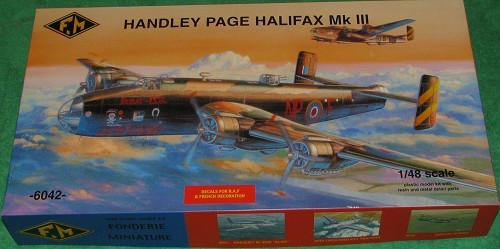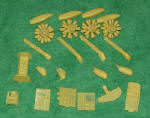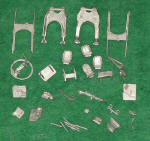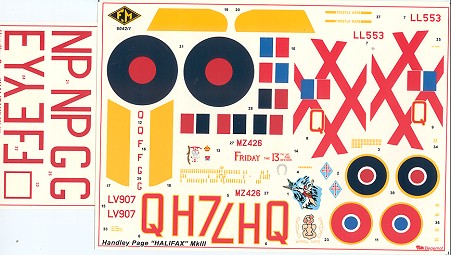
| KIT: | F.M. 1/48 Halifax B.III |
| KIT #: | 6042 |
| PRICE: | $99.98 (89.96 at Squadron) |
| DECALS: | Three options |
| REVIEWER: | Scott Van Aken |
| NOTES: | Short run multi-media kit |

| HISTORY |
Less well-known than the Avro
Lancaster, the Halifax was the other mainstay of Bomber Command operations
between 1943 and 1945. Originally designed as a twin-engine bomber, the
prototype Halifax eventually flew for the first time in October 1939 with
four engines. The first production model was delivered in October 1940 and
eventually two distinct streams of Halifax were produced: those powered by
Rolls Royce Merlin engines (Marks I, II, and V) and those powered by
Bristol Hercules engines (Marks III and VI - IX). The Halifax was widely
known as the "Halibag" by its crews.
Early Merlin-engine Halifaxes had a relatively low operating ceiling that
meant they suffered heavily from ground fire. In 1943 this led to the
Halifax being restricted to attacking less well defended targets. Attempts
to improve the Halifax by streamlining the fuselage, engines, and other
components were not entirely satisfactory, so it was decided to install
more powerful Bristol Hercules engines. The first operational flight of a
Bristol Hercules-engine Halifax occurred in October 1943 with 466 Squadron
RAAF. Eventually, Hercules-engine variants accounted for over half of the
6,177 Halifaxes produced during the war. The Halifax was the only British
heavy bomber that permanently operated from the Middle East, and it was
also widely converted to act as a transport, glider tug, paratroop carrier,
and electronic counter-measures aircraft. Production of the Halifax finally
ceased in November 1946.
As with the Lancaster, a 'civilianized' version of the Halifax, known as the Halton, was produced in small numbers but the idea never caught on as there were a lot of surplus transports on the market after the war that were much more easily converted into airliners.
| THE KIT |
 A
hundred bucks for a short run kit!! You have to be bonkers! Undoubtedly
this is the first thought when confronted with the latest from the French
short run kit maker, Fonderie Miniatures. But let's step back and think
about things for a bit. In comparison to some other 1/48 four engine
bombers, it really isn't that terrible. Sure, the Monogram B-17 and B-24
reissues are only in the $30-40 price range with the B-29 a bit more than
that. But these kits are thirty years old and so the molds have been
amortized and they can afford to sell at a more reasonable price. The other
big heavy in this scale is the Tamiya Lancaster, and though equally as old,
it last sold in the $85 dollar range with any reissue sure to be higher. I
just saw the motorized version at a show and it was $122 retail.
A
hundred bucks for a short run kit!! You have to be bonkers! Undoubtedly
this is the first thought when confronted with the latest from the French
short run kit maker, Fonderie Miniatures. But let's step back and think
about things for a bit. In comparison to some other 1/48 four engine
bombers, it really isn't that terrible. Sure, the Monogram B-17 and B-24
reissues are only in the $30-40 price range with the B-29 a bit more than
that. But these kits are thirty years old and so the molds have been
amortized and they can afford to sell at a more reasonable price. The other
big heavy in this scale is the Tamiya Lancaster, and though equally as old,
it last sold in the $85 dollar range with any reissue sure to be higher. I
just saw the motorized version at a show and it was $122 retail.
Now things aren't looking quite so outrageous.
I mean think of it. Someone has taken the plunge into producing one of the 'big three' in terms of British heavy bombers. F.M. has chosen the most successful of the Halifax versions, the Mk. III which helped to bear the load of Bomber Command's night time bombing effort.
 Molded
in a semi-translucent white plastic, it is typical of what one expects from
French short run kits. Is there flash? Enough to do a 1/72 Spitfire. How
about sink areas and other surface irregularities? Oh yes, you have those as
well, though not as bad as you might expect. Well, I'm sure there are
ejector pin towers. Sure there are, all easily removed. Well how about
resin bits? There is a bag of very nicely done resin. It includes the first
time I've seen full twin row radials done in by F.M. In addition to that,
the carb intakes, 'hedgehog' exhaust, oil coolers, tail wheel well and
various interior bits are done in resin.
Molded
in a semi-translucent white plastic, it is typical of what one expects from
French short run kits. Is there flash? Enough to do a 1/72 Spitfire. How
about sink areas and other surface irregularities? Oh yes, you have those as
well, though not as bad as you might expect. Well, I'm sure there are
ejector pin towers. Sure there are, all easily removed. Well how about
resin bits? There is a bag of very nicely done resin. It includes the first
time I've seen full twin row radials done in by F.M. In addition to that,
the carb intakes, 'hedgehog' exhaust, oil coolers, tail wheel well and
various interior bits are done in resin.
 You
also get a full batch of cast metal bits. These are for the main landing
gear, the tail gear, seats, control column, guns, barrels and a bunch of
other bits and pieces. Though I'd have liked to have seen the gun barrels
in resin (as most of the skinny metal bits will have to be straightened
out), at least with them in metal they won't be easily broken.
You
also get a full batch of cast metal bits. These are for the main landing
gear, the tail gear, seats, control column, guns, barrels and a bunch of
other bits and pieces. Though I'd have liked to have seen the gun barrels
in resin (as most of the skinny metal bits will have to be straightened
out), at least with them in metal they won't be easily broken.
Clear bits are injected plastic for the flat windows and vacuformed plastic for those that have any curve in them like the cockpit, bombardier's nose piece and the gun turrets. Since F.M. cares about its customers, there are spares of all these vacuformed pieces. The molding is fairly well done. Not Falcon standards, but not bad. Hidden in the bottom of the box and so not shown is a photo-etch fret as well. This includes seat belts (for the pilot only), some throttle bits and some rather complex looking bits for the bomb bay doors as well as some sort of radar antennas that fit to the side of the nose (like you see on photos of C-47s).
The cockpit and bombardier's section is quite well detailed with all these various bits available. You also can position the bomb bay doors open and you have some ordnance to stick in there so it won't look too empty. The flaps are also separate so that they can be placed in the lowered position. While this is a nice option, my ancient (1960) William Green 'Bombers of the Second World War' reference shows them all with the flaps up. Perhaps this was the norm, but you do have the option. I should also point out that FM has provided some rather beefy spars to hold those wings onto the fuselage. The huge main wheels are weighted and I'm thinking that perhaps the True Details Lancaster resin wheels will fit.
Instructions are really rather good.
The dual French/English instructions are not bad. the construction drawings
are a bit crude compared to someone like Italeri, but they are well done
and provide what appears to be fairly good parts placement information.
Really, only building will show any areas that need improved. There is no
interior or piece color information
 given. I can only assume
that the folks at FM figured that you should have a pretty good idea of
what colors to paint the inside of these things (mostly British Interior
Green). There are three markings options. All are the same colors of Dark
Earth/Dark Green over Black. There are two decal sheets provided, one of
which is quite large. You have markings options for three planes. One with
a red lattice outer fin is French from 346 Sq, while of the other two
British planes, one has yellow diagonal stripes is from 158 Sq and the
second, with white horizontal stripes on the fin, is unknown as it appears
to be a late addition. (Late note; the color of the nose art for
'Munga Taipo' is
incorrect and this Maori figure should be green with red lettering. This
according to reader Bill Bourke who did a presentation model of this plane
using photos from the crew of the aircraft.) The decals themselves are matte and fairly well
printed. I'm thinking that the red on the main sheet may be a bit too
bright, but perhaps it will darken when applied. They are spot on regarding
register from what I can see. I know of no aftermarket decals in this scale
so these will have to do. If doing one of the British planes, it may not be
a bad idea to paint on the fin markings.
given. I can only assume
that the folks at FM figured that you should have a pretty good idea of
what colors to paint the inside of these things (mostly British Interior
Green). There are three markings options. All are the same colors of Dark
Earth/Dark Green over Black. There are two decal sheets provided, one of
which is quite large. You have markings options for three planes. One with
a red lattice outer fin is French from 346 Sq, while of the other two
British planes, one has yellow diagonal stripes is from 158 Sq and the
second, with white horizontal stripes on the fin, is unknown as it appears
to be a late addition. (Late note; the color of the nose art for
'Munga Taipo' is
incorrect and this Maori figure should be green with red lettering. This
according to reader Bill Bourke who did a presentation model of this plane
using photos from the crew of the aircraft.) The decals themselves are matte and fairly well
printed. I'm thinking that the red on the main sheet may be a bit too
bright, but perhaps it will darken when applied. They are spot on regarding
register from what I can see. I know of no aftermarket decals in this scale
so these will have to do. If doing one of the British planes, it may not be
a bad idea to paint on the fin markings.
| CONCLUSIONS |
So there you go. A 1/48 Halifax and who would have thought we'd see one. Yeah, it is a short run kit and it will undoubtedly take quite a bit of work to complete, but you know, when one buys a kit like this, one expects certain things like that. For certain, the end result will be a beauty and will be something of which the builder can be proud. I've already started on this one so you can expect a full build review, though it won't be real soon!
May 2005
You can find this kit and many others at

If you would like your product reviewed fairly and quickly by a site that has around 300,000 visitors a month, please contact me or see other details in the Note to Contributors.